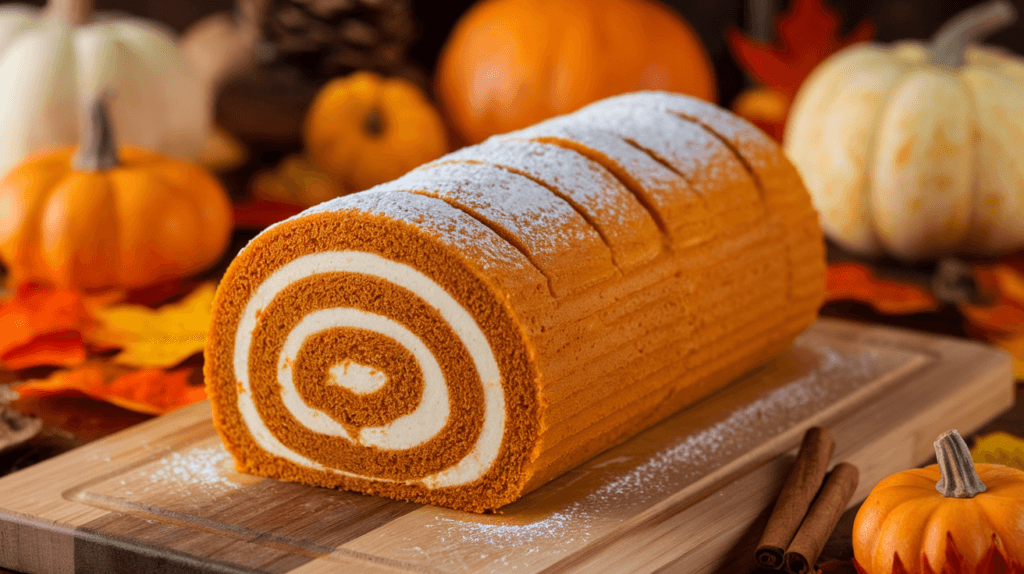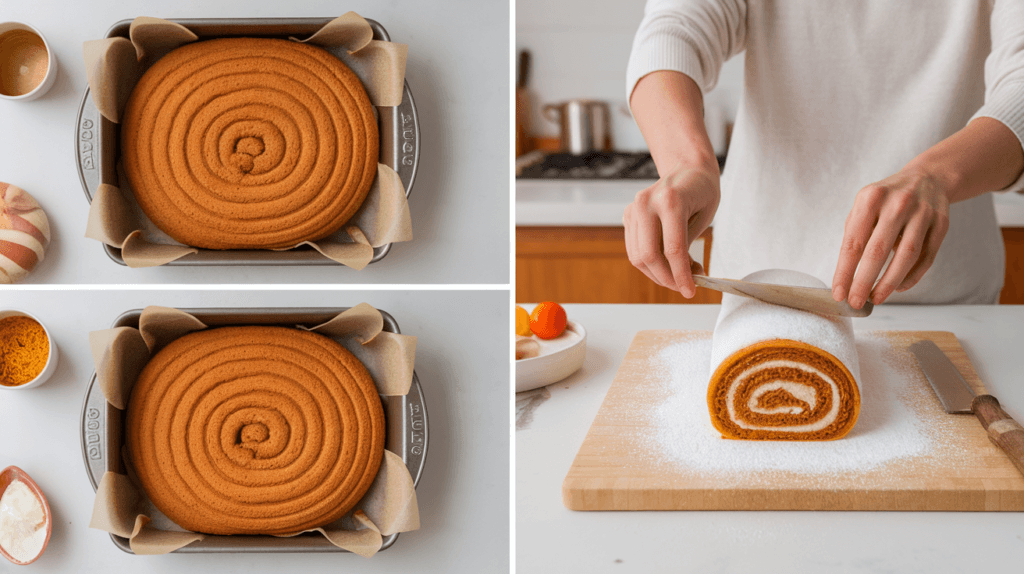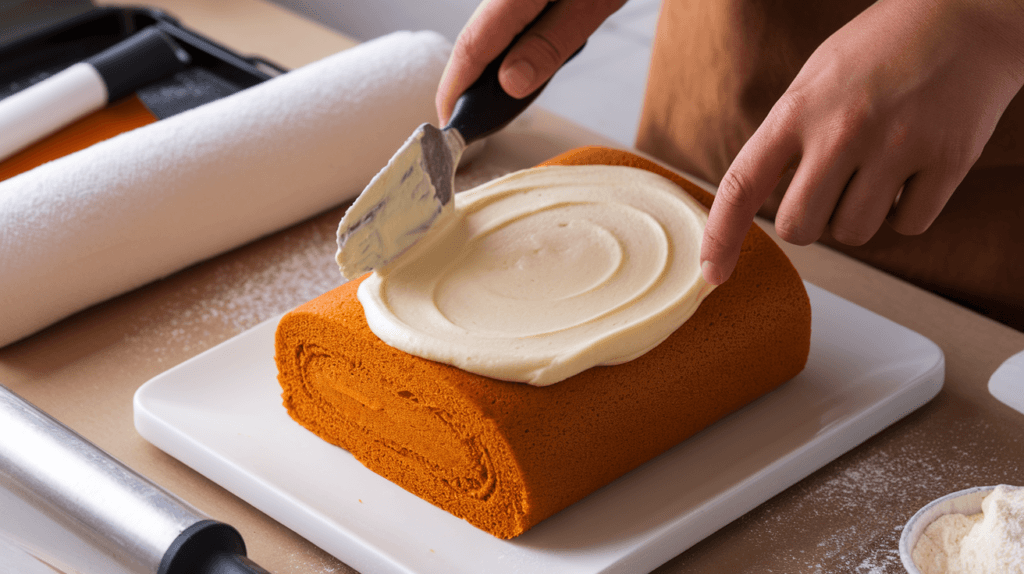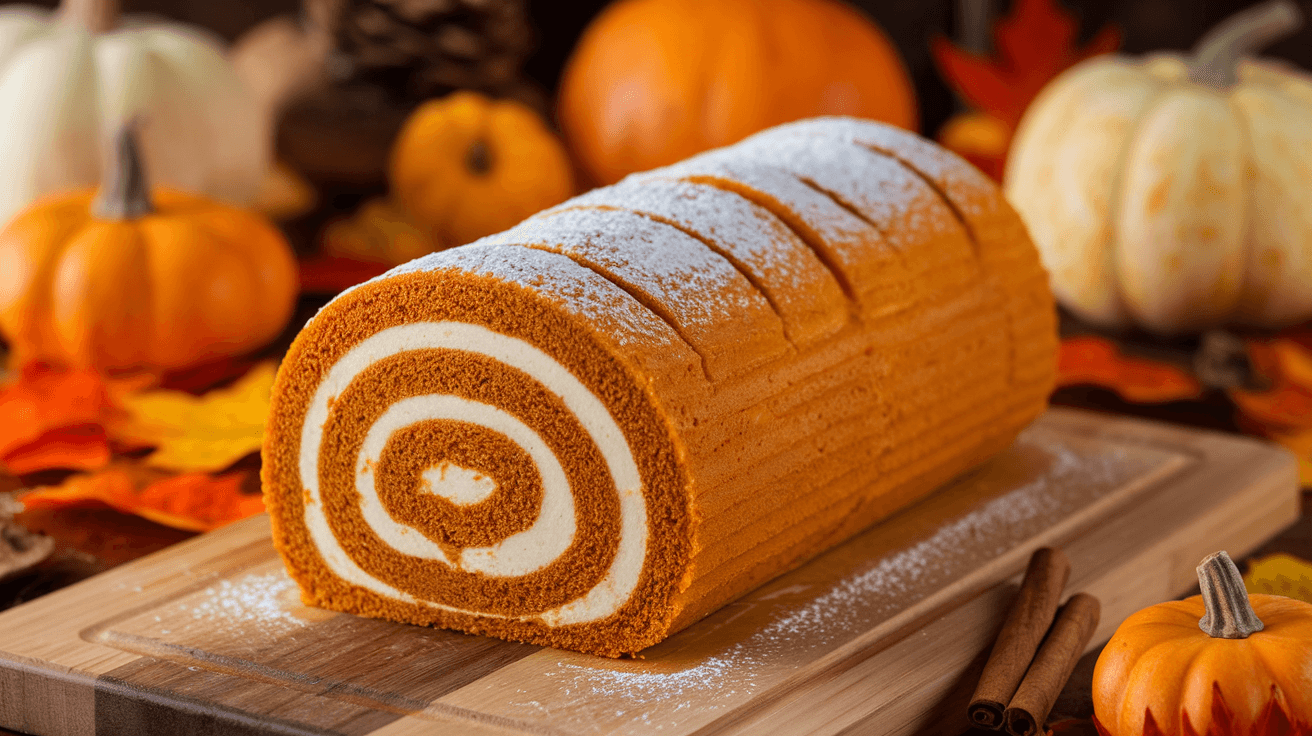Introduction
There’s nothing quite like the satisfaction of creating a beautifully rolled pumpkin roll. This classic dessert combines the warm, spiced flavor of pumpkin with a creamy, luscious filling, offering a perfect harmony of taste and texture. However, rolling the cake successfully can sometimes turn into a baker’s nightmare when cracks appear during the process.

Cracked pumpkin rolls are a common issue that can leave even experienced bakers puzzled. If you’ve ever wondered, “Why did my pumpkin roll crack when I rolled it?”, you’re not alone! Understanding the causes behind these cracks and how to avoid them is key to mastering this dessert.
In this article, we’ll explore why your pumpkin roll cracked when you rolled it and provide actionable tips to help you achieve a perfect pumpkin roll every
Why Does My Pumpkin Roll Crack? Understanding the Causes
Cracks in a pumpkin roll can be disheartening, but they often stem from common missteps during the baking and rolling process. If you’ve ever asked yourself, “Why did my pumpkin roll crack when I rolled it?”, understanding the root causes is the first step to prevention. Let’s explore why these cracks form and how you can avoid them in the future.
How Rolling Can Cause Pumpkin Roll Cracks
The rolling process is one of the most delicate stages when making a pumpkin roll. The cake is rolled into a spiral, creating tension along its surface. If the cake lacks flexibility or moisture, the pressure from rolling can cause the surface to split or crack.
The Role of Moisture in Preventing Pumpkin Roll Cracks
One of the most important factors in preventing cracks is the moisture level of the cake. A properly baked pumpkin roll should have enough moisture to stay pliable during rolling. If the cake is too dry, it will likely crack as it bends.
Why Cake Thickness Matters in Pumpkin Roll Cracking
Another critical factor is the thickness of the cake. If the sponge is too thick, it may not roll smoothly. A thinner, evenly baked cake allows for a gentler and more uniform roll, reducing the likelihood of cracks.
Understanding these underlying factors is the first step toward troubleshooting and preventing cracks in your pumpkin roll. Next, we’ll dive into the variables that directly affect your results, from batter preparation to cooling techniques.
Key Factors Behind Pumpkin Roll Cracking

Creating the perfect pumpkin roll requires attention to detail at every step of the process. If you’ve been wondering, “Why did my pumpkin roll crack when I rolled it?”, the answer often lies in factors like batter preparation, baking time, and cooling techniques. Each of these elements plays a crucial role in determining whether your roll stays smooth or cracks under pressure. Let’s break down these critical factors.
Batter Consistency and Moisture
The foundation of any successful pumpkin roll starts with the batter. A properly mixed batter should have the right balance of moisture and structure. Overmixing can make the cake dense and dry, while undermixing may result in uneven textures, both of which increase the likelihood of cracks during rolling. Always follow your recipe’s measurements and mixing times closely to ensure consistency.
Baking Time and Temperature
Overbaking is a common culprit behind cracks in pumpkin rolls. When a cake is baked for too long, it loses its moisture and becomes brittle, making it prone to breaking when rolled. Conversely, underbaking can leave the cake too soft and sticky to handle. To find the sweet spot, bake your pumpkin roll at the recommended temperature and test for doneness using a toothpick. It should come out clean but not dry.
Cooling Techniques
Proper cooling is another critical step to prevent cracking. After removing the cake from the oven, it should be transferred to a prepared surface, such as a clean kitchen towel dusted with powdered sugar. Rolling the cake while it’s still warm helps set the spiral shape and reduces tension that could lead to cracks. Allowing the cake to cool completely in its rolled form ensures it retains flexibility when unrolled and filled.
By mastering these factors, you can significantly improve the quality of your pumpkin roll. However, avoiding mistakes is just as important as following the right techniques. Next, we’ll address common mistakes that lead to cracking and how to avoid them.
Common Mistakes That Cause Pumpkin Roll Cracks
Even with a solid understanding of techniques, small mistakes during the preparation, baking, or rolling process can lead to cracks in your pumpkin roll. Let’s explore some common missteps and how to avoid them for a seamless roll every time.
Overbaking the Cake
One of the most frequent causes of cracking is overbaking. When a cake is left in the oven too long, it dries out, losing the flexibility needed to roll properly. To avoid this, set a timer and check the cake a few minutes before the recommended baking time. A toothpick inserted into the center should come out clean but not overly dry.
Not Preparing the Towel Correctly
Another crucial step often overlooked is preparing the rolling towel. A clean kitchen towel should be generously dusted with powdered sugar before the cake is placed on it. This prevents the cake from sticking and makes rolling easier. Forgetting this step or using insufficient powdered sugar can cause the cake to tear or crack when rolled.
Rolling Too Late or Too Soon
Timing is everything when rolling a pumpkin roll. If you wait too long after removing the cake from the oven, it may cool and lose the flexibility needed to roll without cracking. On the other hand, rolling it too soon, while it’s still overly hot, can cause it to stick to the towel or deform. The sweet spot is to roll the cake while it’s warm and pliable but not scalding.
Skipping the Parchment Paper
Forgetting to use parchment paper can make it difficult to release the cake from the baking pan, leading to breaks or cracks. Always line your pan with parchment paper before pouring in the batter to ensure an easy release and a smooth rolling process.
Using Incorrect Filling Techniques
Even if the cake is perfectly baked and rolled, cracks can still appear. If you’ve been asking, “Why did my pumpkin roll crack when I rolled it?”, the filling might be to blame. Applying the filling unevenly or too thickly creates stress on specific parts of the cake during the final roll. To prevent this, spread the cream cheese filling in a thin, even layer across the surface, reducing unnecessary strain.
By avoiding these common mistakes, you can significantly improve the appearance and integrity of your pumpkin roll. Next, we’ll focus on proactive techniques to ensure a perfect roll every time.
How to Prevent Cracks: Techniques for a Perfect Pumpkin Roll

Achieving a flawless pumpkin roll requires a combination of proper preparation, careful baking, and precise rolling techniques. If you’ve ever wondered, “Why did my pumpkin roll crack when I rolled it?”, these tried-and-true methods will help you avoid cracks and ensure your pumpkin roll turns out perfectly every time.
Proper Batter Preparation
The journey to a crack-free pumpkin roll begins with the batter. Start by measuring your ingredients carefully and mixing them just enough to combine. Overmixing can cause the cake to become dense and prone to cracking. Be sure to sift your dry ingredients to avoid lumps, which can disrupt the cake’s texture. A smooth, well-aerated batter ensures an even and pliable cake layer.
Using the Right Pan and Tools
Always use a jelly roll pan of the correct size, typically 10×15 inches, to avoid asking later, “Why did my pumpkin roll crack when I rolled it?” The proper pan size ensures the cake is thin enough to roll easily. Line the pan with parchment paper to prevent sticking, and lightly grease the sides to help the cake release effortlessly. These small but essential steps go a long way in preserving the cake’s integrity.
Rolling While Warm
The key to a smooth roll is to act quickly after the cake comes out of the oven. Lay a clean kitchen towel dusted with powdered sugar over the cake, and carefully flip the cake onto the towel. Peel off the parchment paper gently, then roll the cake up with the towel still inside. Rolling while the cake is warm helps it “learn” the spiral shape, preventing cracks later when you add the filling.
Cooling Completely Before Filling
Allow the rolled cake to cool completely at room temperature before unrolling it to add the filling. This step ensures the cake sets in its rolled shape and reduces the risk of cracking during the final assembly. Be patient—cutting corners here can lead to tears.
Applying the Filling Evenly
When it’s time to add the filling, spread it evenly in a thin layer across the entire cake. Avoid overloading the center, as this can create uneven pressure during the final roll. Use an offset spatula to achieve a smooth application, and leave a small border around the edges to prevent overflow.
By mastering these techniques, you’ll be able to create a pumpkin roll that is not only visually stunning but also structurally sound. In the next section, we’ll address common questions and provide solutions for fixing cracked rolls and preventing them in the future.
FAQs on Pumpkin Roll Cracks
Even with the best techniques, you might still encounter a few challenges when making a pumpkin roll. Below, we answer some frequently asked questions to help you troubleshoot and perfect your pumpkin roll process.
Why Does My Pumpkin Roll Break When I Roll It?
Your pumpkin roll may break due to dryness or improper handling. Overbaking is the most common cause of a dry cake, as it loses the moisture needed to remain pliable. Additionally, failing to roll the cake while it is warm can cause it to cool in a flat shape, making it prone to cracking when bent.
Can I Fix a Cracked Pumpkin Roll?
Yes, minor cracks in a pumpkin roll can often be fixed. If a crack appears, you can use extra filling to cover it up or gently press the broken sections together during the rolling process. For more severe cracks, slice the roll into portions and present it as individual servings to disguise the imperfections.
How Can I Prevent Cracks in the Future?
To prevent cracks, focus on proper timing and technique. Bake the cake just until done and roll it while it’s still warm. Ensure your batter is mixed correctly and the cake is evenly baked. Additionally, use enough powdered sugar on the towel to prevent sticking and tearing.
Why Does My Cake Stick to the Towel?
Sticking occurs when there isn’t enough powdered sugar on the towel or when the cake hasn’t cooled properly before unrolling. To avoid this, dust the towel generously with powdered sugar and handle the cake gently during the unrolling process.
Is There a Substitute for the Kitchen Towel?
If you don’t have a kitchen towel, you can use parchment paper or wax paper dusted with powdered sugar. These alternatives work well to prevent sticking and are easier to discard after use.
What If My Pumpkin Roll Looks Uneven?
An uneven pumpkin roll can result from spreading the batter unevenly in the pan or not rolling the cake tightly. Always smooth the batter in the pan before baking and roll the cake firmly but gently to maintain a uniform shape.
With these tips and solutions, you can troubleshoot common issues and improve your technique for future pumpkin rolls.
Conclusion
Baking a pumpkin roll is both an art and a science. While cracks may happen occasionally, they are entirely avoidable with the right approach. From ensuring proper batter consistency to rolling the cake at just the right time, every step plays a vital role in achieving a flawless result.
Even if cracks appear, don’t be discouraged—these imperfections can often be fixed or cleverly hidden. Practice makes perfect, and with the tips shared in this article, you’ll soon master the technique and enjoy creating stunning, crack-free pumpkin rolls for every occasion.
Happy baking!

